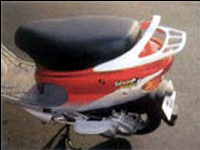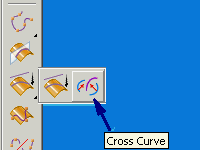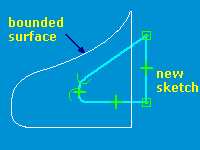
SeGuruCool
The Largest Independant Solid Edge Resource Outside UGS PLM

SeGuruCool The Largest Independant Solid Edge Resource Outside UGS PLM |
|
Application 3 of 3 www.oocities.org/SeGuruCool  segurucool @ indiatimes.com segurucool @ indiatimes.com |
|
|
|
Bend It - Prologue This tutorial is continuation in the series of the article - Bend It Like...A CrossCurve This series of three tutorials show you how to make three varieties of the same object - A BackRest - using the cross curve tool. |  |
|
Front View Curve Begin by creating a curve in the x-z plane. |  |
|
Front View Curve - Normal View When viewed in the sketcher, the curve would look something like as shown in figure. Apply tangent relationship to all connected curves. Here, the dimensions or even the form of the backrest is not important. This tutorial shows you the approach to create the backrest. You may go out into the parking and take actual measurements. |  |
|
Top View Curve Create another curve (an arc) in the x-y plane. See figure. |  |
|
Top View Curve - Normal View The Top view curve may extend beyond the limits of the front view curve drawn earlier. But in no case should the new curve fall short of the extents of the earlier curve. |  |
|
Cross Curve Select the Cross Curve command from the Surfacing toolbar as shown. |  |
|
First Curve Select the top view curve as the first curve. Click accept  on the ribbon bar. on the ribbon bar.
|  |
|
Second Curve Select the front view curve as the second curve. Click accept  on the ribbon bar. on the ribbon bar.
|  |
|
Cross Curve Click Finish on the ribbon bar. Soon the cross curve is formed. The cross curve is neither in the top plane nor in the side plane. It travels in 3D space, giving us the desired curve to create the backrest. In other words, the front view curve is effectively bent by the top view curve. |  |
|
The Bounded Surface Hide all sketches. Click the Bounded Surface  command from the Surfacing toolbar. command from the Surfacing toolbar.
Select all the edges of the cross curve by dragging a window around it. Click Finish on the ribbon bar. A surface will be formed from the edges. |  |
|
Sketch in Parallel Plane Create a sketch in a plane parallel to the y-z plane as shown. |  |
|
New Sketch Normal View The curve extends outside the right part of the bounded surface. See figure. |  |
|
Project Curve - Curve Step Select the Project Curve  tool from the Surfacing toolbar. tool from the Surfacing toolbar. Select the sketch as the curve to project. Click accept  on the ribbon bar. on the ribbon bar.
|  |
|
Project Curve - Body Step Select the bounded surface as the surface to project on. |  |
|
Project Curve - Direction Step Point the arrow down towards the surface and click. Click Finish on the ribbon bar. |  |
|
Project Curve - View It If required, click the Visible and Hidden Edges  tool on the Main toolbar to see the projected curve. tool on the Main toolbar to see the projected curve.
|  |
|
Trim Surface - Surface Step Select the Trim Surface  tool from the Surfacing toolbar. tool from the Surfacing toolbar. Select the bounded surface as the surface to trim. |  |
|
Trim Surface - Curve Step Select the projected curve as the trimming curve. Click accept  on the ribbon bar. on the ribbon bar.
|  |
|
Trim Surface - Side Step Indicate the arrow pointing downwards as the part to trim off. See figure. |  |
|
Surface Trimmed The bounded surface is trimmed as shown in figure. |  |
|
Surface to Solid Click the Thicken  tool on the Features toolbar. tool on the Features toolbar. The Thicken tool is in the same flyout as the Thin Wall and Thin Region tools. Select the trimmed bounded surface to thicken. Use an appropriate value to thicken in any direction. Round off sharp edges of the backrest and mirror the half part to complete the backrest. |  |
Tushar Suradkar  segurucool @ indiatimes.com segurucool @ indiatimes.com |